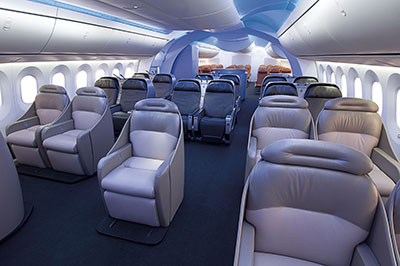
Features
Operations
Glide Path: It’s all about the technology
I had a minor epiphany recently on the subject of In Flight Entertainment (IFE) systems and the decisions aircraft manufacturers, suppliers and airlines will be facing in the coming decade.
November 14, 2013 By Paul Dixon
I had a minor epiphany recently on the subject of In Flight Entertainment (IFE) systems and the decisions aircraft manufacturers, suppliers and airlines will be facing in the coming decade. I was in Seattle at the Seating & IFE Symposium, part of the Aircraft Interiors Expo. More than 300 people with vested interests in what goes on inside an aircraft from an entertainment and seating point of view were partaking in a full day of presentations, panel discussions and bear pits on the challenges of meeting public expectations. Of course, the big challenge was identifying “the public” and determining what it is they want.
 |
|
| Of course, the big challenge was identifying ‘the public’ and what it is that they want. Paul Dixon is freelance writer and photojournalist living in Vancouver.
|
Apart from the paint job, all aircraft of any particular model look pretty much the same on the outside. One B777 or A330 looks pretty much the same as all the others and they all take about the same amount of time to get you from one place to another. The inside of the aircraft is where the airline has the opportunity to brand itself: that’s where customers spend all their time while waiting to get where they’re going. The lighting, the palette of colours, the seats and a hundred other things you might never think of are what an airline agonizes over in its effort to put some space between itself and the competition; while at the same time, it strives for aircraft that are lighter, quieter and stronger.
IFE catches your attention in a way that polymer resins fail to excite. There are studies that suggest that by the end of the current decade, 90 per cent of North Americans will have a tablet or smartphone. So, how do the airlines react to this? Air Canada and WestJet have both taken a “wait and see” approach in this regard. Around the world, airlines are realigning into three basic classes: a handful of super-premium airlines that will continue to offer both first-class and business class along with economy; those that have cut back to business class and economy; and one-class economy-only airlines. The super-premium airlines are going all-in with current technology, while the low-cost carriers are offering essentially nothing; the passenger provides his or her own entertainment. The bulk of the world’s airlines that make up the middle class of aviation are faced with the challenge of meeting customer expectations without pricing themselves out of their markets.
It seems almost inevitable that one day we will live our lives almost exclusively through our smartphones or tablets. This is certainly true with regards to airlines and air travel. You will book your flight, choose your seat, receive your electronic boarding pass, track your baggage, order your meal and even arrange your inflight – all with your phone. That day is coming – and many of those options are already here with some airlines – but there’s a lot of work that the average airline passenger doesn’t consider or simply isn’t aware of. It’s one thing for an airliner to order a new B787 or A380 with the latest and greatest electronics, but what does it do with its aircraft that haven’t hit the halfway point in their lifespan? Where does this asset fit into the business model? Do you strip out the interior of a 10-year-old wide-body in order to upgrade the IFE or do you go with a new model?
There’s also the challenge of dealing with the regulators in a world where technology changes at a rate that outstrips the regulator’s willingness and/or ability to deal with the questions that arise. The electronic flight bag is a prime example, one where regulators are allowing the use of electronic devices in a tightly controlled environment. And when you read between the lines, the regulators have a much greater expectation of compliance with regulations from the people in the cockpit than they do with the people in the back of the plane. Even the biggest champions of unfettered IFE systems will admit that, yes, there is always going to be the question of the impact of future technology.
On the positive side, however, industry demand has brought the seat manufacturers and IFE vendors into a collaborative work environment where they work together with large customers such as Boeing and Airbus, right from the initial design concept – instead of working in their own silos with no communication. The result has seen product and delivery times that used to be measured in years cut to months. Beyond that, the seat people and the IFE people are brainstorming potential configurations so that whether it’s the airlines looking for a mid-life refit on their existing fleet or the OEMs thinking about the next generation of air travel, they are leaning forward with a number of potential solutions to offer.
As a not-so-avid techno-geek who isn’t tied to his tablet or iPhone, I don’t know what’s coming next or how long it’s going to be before it comes to an airliner near you. So, in the meantime, I’ll bring a good book.
Paul Dixon is freelance writer and photojournalist living in Vancouver.